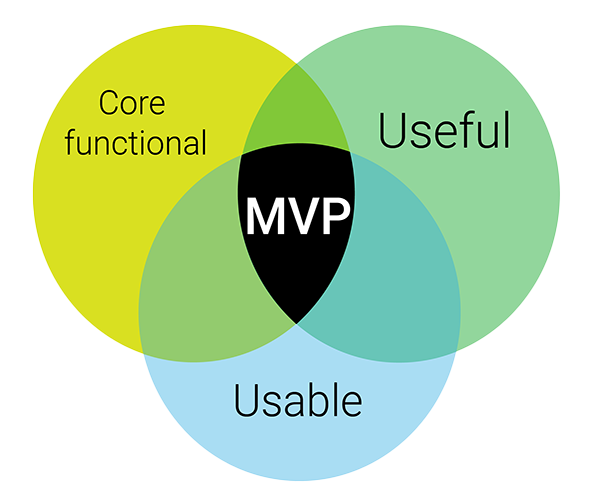Building MVP for Startups
Table of Contents
Intro: Essential Notions
The Process and Development
Benefits
Pitfalls
Minimum Valuable Product (MVaP)
Final Thoughts
Some Cases from Sibers’ Experience
Intro: Essential Notions
Starting a business can be tough. In fact, about 80% of IT startups fail within the first year. The reasons are many: poor-quality product, no market need, running out of cash, lack of research, poor technological expertise, bad marketing, and costing/price issues.
The good news is, most of these problems can be predicted and avoided through a common practice called “Minimum Viable Product”, or “MVP”. Building an MVP is one of the first steps in launching an application or software. At Sibers, we have plenty of experience building MVPs and turning them into full-featured products, and we’re happy to share some insights.
In this article, we’ll discuss MVP as a startup business approach.
What is an MVP?
A Minimum Viable Product is a basic version of a product that includes only its core features. It is used to test the viability or sufficiency of an idea for the market: in other words, whether the product delivers any value to users. Despite its name, an MVP is not really a product, but instead a process for building a good-quality product.
An MVP is intended to solve only the core problem of a target user group. Over time, as you gain user feedback data, you can add more functionality to the product. For example, say you want to make an innovative, AI-powered photo editor. The MVP approach supposes that you start with just one key feature – e.g., a smart background remover – and test its viability before moving on to other features.
An MVP should also be useful and usable. You want to be sure that it solves a problem and that its UI is easy and intuitive.

The whole idea of the MVP stage is to collect data and analyze it. Your goal is to gain a wide range of useful information from the launch: user feedback, market analysis, cost overview, and the results of checking your hypotheses. All of this data will help your product thrive.
You should choose the MVP approach if:
- You have an innovative but untested idea. Before spending lots of money, it’s crucial to confirm the idea’s feasibility and whether it’s even technically possible.
- You have a tight budget. Building an MVP is the cheapest path for product development.
- You want to attract investors. A good MVP can win them over and gain you valuable financial support.
- You want to test several ideas. The MVP approach is a cheaper, less time-consuming solution for trying them all and finding the best one(s).
- You are an expert and you’ve found a problem that nobody has yet solved, but you still need to test the sufficiency of your idea and the market’s need.
- You need to add a new direction to an already existing product. An MVP is full of analytics, testing, and optimizing. It allows you to carefully implement new features without time, money, or reputational loss. You can also pursue an “MVaP approach” here, which we’ll discuss later on.
The Process and Development
Once you decide to make an MVP, you should start by defining the main characteristics of your product: for example, the idea, the target audience, the problem you want to solve, and your main goals. Do the market research. Are there any products on the market similar to yours? How many users do they have? Are they popular? Why, or why not? It’s also useful to interview your target audience. What are their pains? What are they seeking in a product like yours? Once you’ve answered these questions, you should decide on your product’s features and create a user flow. Pare everything down to only what is strictly necessary, and focus on one feature for each step.
After you’ve defined the scope of work, you can proceed with developing the actual MVP. The development is honestly the easiest part of the process, especially when it is done by a professional team like Sibers. The most important thing is to choose a suitable tech stack — something cost-effective, reliable, and scalable. Depending on your product and your plans, we’ll recommend the perfect technology. For example, for a web app with an aim to go mobile, we would recommend using React or Angular frameworks because they are easily convertible to mobile and rather popular – meaning it wouldn’t be a problem to hire more developers. For real-time apps such as messengers or video conferencing, we usually choose Node.js because it is high-performance, scalable, and allows for building cross-platform apps.
When development is complete, it's time for the first “release”. It’s up to you whether to make it public or to start with a focus group. What’s most important is to get feedback from users. Depending on this feedback, you may need to take the MVP through several iterations – until at last, after analyzing all the data, you come to a decision of whether to continue building a full product or whether to change direction and pursue a different objective.
Benefits
In general, what advantages does the MVP approach offer?
- A workable version of a product in a short amount of time.
- Minimal investment due to minimum functionality. Once your MVP proves successful, you can invest in new features and expand the product’s functionality. However, at the MVP stage, multiple features are expensive and usually unprofitable.
- Confirm the viability of the concept.
- Obtain user feedback, which is crucial for further improvement and development. This will help you understand how to make your product more appealing and how to fully meet the needs of your target customer.
- Attract investors. The MVP stage is perfect for showcasing your product to them.
Pitfalls
When developing an MVP, you should keep in mind the following nuances in order to avoid problems in the future (and be able to upscale).
- It's a common mistake to choose a technology stack capable enough for building only a basic version. Ask your developers to recommend a scalable technology that can start simple and then grow into a full-featured product without a massive redesign.
- Releasing a low-quality MVP can be harmful to the reputation of your product. When your product is introduced to the first users, their first impression should be positive. This is especially important when there is strong competition in your market niche. To avoid reputational loss, make sure your MVP works smoothly before showing it to users.
Minimum Valuable Product (MVaP)
An extension of Minimum Viable Product (MVP) is Minimum Valuable Product (MVaP). This literally means that the product should carry some value.

First and foremost, this means value for the users. Keep this in mind and prioritize your users and their needs and expectations. The MVaP approach requires that you analyze usability, evaluate demographics, and create user cases. Once you have several ideas about how to meet your users' needs, you can focus on testing prototypes. Providing functional prototypes to actual users is integral for determining the best ways to meet the needs of your potential customers.
MVaP should also benefit the project itself. Like an MVP, it extracts useful information about the perception of the product on the market.
Finally, value is also created for the business. One of the risks of releasing MVPs is that they can reflect badly on the reputation of the brand (if done inaccurately and presented as a “raw” version). Therefore, many big companies prefer to choose a safer path: MVaP.
Of course, the development of an MVaP is more costly, but it is guaranteed to carry value and positively affect the image of the brand it represents.
Final Thoughts
Don’t be confused by the word “minimum”. Ant MVP is not, and cannot, be slapdash. The key features must be well-designed and solid, so that even in the basic version they are valuable to users and attractive for investors. That said, realize that the MVP is only the first stage of a product’s development and you shouldn’t expect too much of it. It is part of a process, and there will be lots of changes before your idea becomes a full-featured, quality product.
The MVP provides businesses with valuable data for making improvements. The goals can be varied — to gain feedback on the basic features; minimize the initial development cost; check technical feasibility; and create something to show your investors. Moreover, the MVP can be exploited both when you create a new product, and further on when you add features to an existing one.
Some Cases from Sibers’ Experience
Sibers provides software development services for businesses of all kinds. Even if all you have is an idea, we can help you prove its viability for yourself and your investors. We have huge experience in building proof-of-concepts and MVPs. And when you’re ready to go further, we can turn it into a full-featured product. Here are three real cases from our experience:
Idea→PoC→MVP→SaaS
A manufacturer of custom steel beams and roofing accessories asked us to create a web app with an order management system and a unique product drawings editor. We started with a proof of concept: the implementation of a React.JS editor. The client decided to move forward and we began working on the OMS and the backend and created a workable MVP that would be used by the client internally. After a significant time of internal usage and improvements, we expanded the solution and it became a SaaS startup in the manufacturing space.
Minimization of risk
The idea was to create an iOS app that connected parents and nannies. We developed an app with the primary function of tracking and displaying a nanny's location. Additionally, the app had basic social functionalities such as chat and reporting. The client performed focus group beta-testing through a "weekly support group for mommies", and used this group as a testbed for the app. Before long, the MVP version was released in the App Store.
Unfortunately, the app didn't attract an audience and the project was closed. Fortunately, the client did not spend a lot of time and money on a full-featured app – instead, she created an MVP and checked the product’s viability before investing real money. This is a good example of how to minimize risk and prevent a huge money loss.
Something to show to investors
A client from the UK wanted to create a B2B travel management web application that gives small- and mid-sized enterprises fast, easy tools for business trips. At the MVP stage, the client focused on a "train search", since the research showed that UK companies mostly use trains for business trips. The Sibers team joined to speed-up the process.
We developed a mobile-responsive JS front-end for a web-based platform that covered all the needs for business travel management: searching, booking, analyzing travel history, and more. We also developed a PHP promo website.
The project was incredibly successful. The client showcased the MVP at various conferences and earned a sponsorship. The project also won several accolades, including:
- Winner of the ‘Disrupt Launchpad Award’ at the 2019 Business Travel Show
- 'One to Watch' on the ‘Buying Business Travel 2019 Hotlist’
- Listed as one of the ‘Top 5 Exciting Startups in the Travel Management Space for 2018’ by the Guild of Travel Management (GTMC).